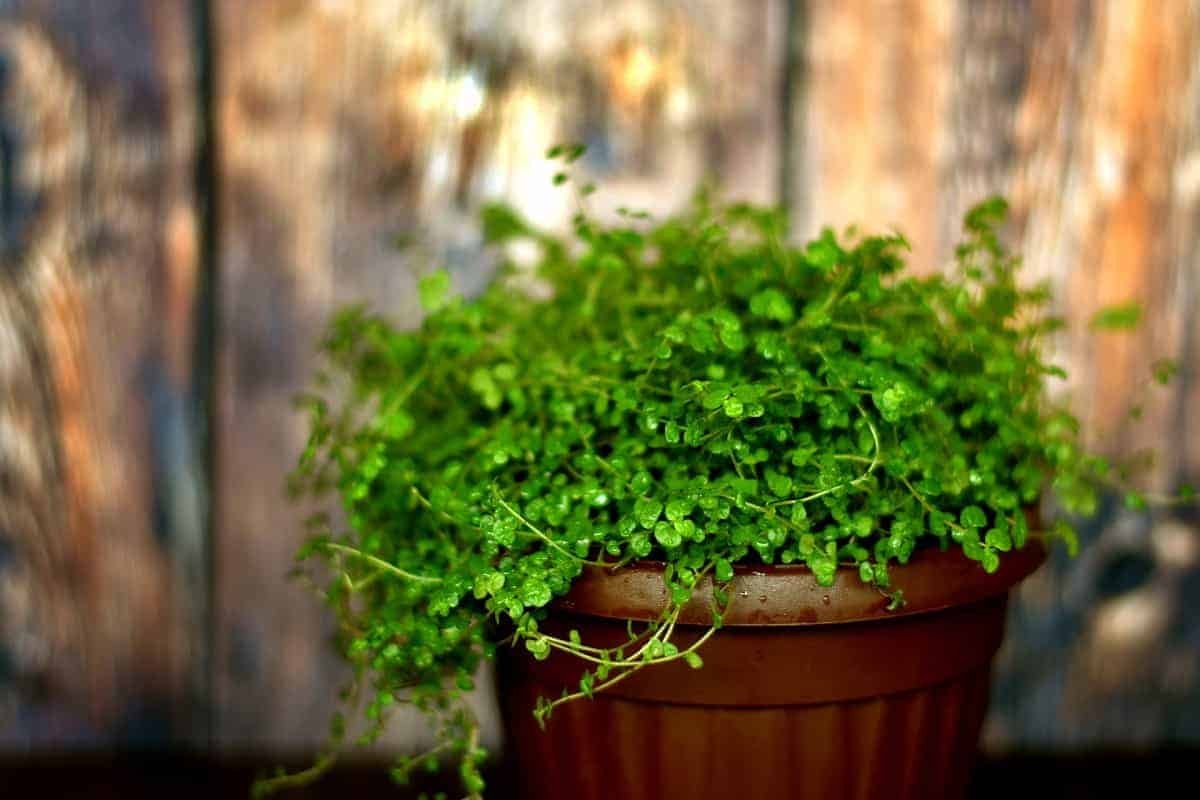The plants listed here have leaves that are generally less than a 1/2″ in size. When the leaves are longer than wider, I take into consideration the whole area size. For example: Chives have tall, slender leaves that can reach up to 12″ high. I do not consider those as having tiny leaves.
Table of Contents
Alyssum
Often referred to as Sweet Alyssum because of its honey-like smell, the blooms are sometimes so prolific that they will cover the tiny leaves. The leaves are slender and tapered, less than 1/8″ wide. Botanical name: Lobularia maritima. Generally sold as an annual but can be a short-lived perennial in warmer climates.
Artillery Plant
Used as a ground cover in zones 9 and above but is considered very invasive. Can be a lovely houseplant, with succulent like leaves less than 1/2″. Artillery Plant (Pilea microphylla), does best in sun to partial shade so bright light near a southern window works best.
Baby’s Tears
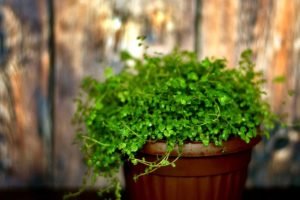
Baby’s Tears (Soleirolia Soleirolii) is a sweet plant with the tiniest of leaves and makes a great houseplant, fairy garden plant, or outdoors in zones 9 and up.
The USDA plant database lists its common name as Dandy Mother of Thousand which I had never heard of. Other common names are Angel Tears, Mind Your Own Business, and Pollyanna Vine.
You can buy a yellow variety of Babys Tears at The Miniature Garden Shoppe online (based in IL, USA). Some international shipping is available.
There is a Dwarf Babys Tears which is actually a different plant but looks very similar. You can get it on Amazon as Hemianthus callitrichoides.
These plants like humid conditions so misting several times a week might be necessary unless you put them in a terrarium. Used as an indoor fairy garden plant, it will require some cutting back from time to time, like mowing the lawn.
Blue Star Creeper
The Blue Star Creeper (Isotoma fluviatilis) is a perfect perennial for beginners and experts alike. This aggressive ground cover plant has thick, waxy leaves that are dark green in color, up to half an inch in size with deep blue flowers that bloom in early summer.
It’s a gorgeous, easy-to-grow flower that thrives in the shade and looks beautiful between stepping stones.
Corsican Mint
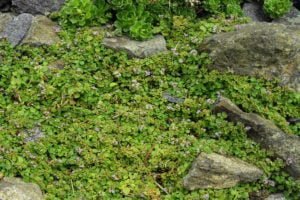
Another great ground cover, Mentha requienii also makes a great tea! It has round bright green leaves around 1/4″ in size and grows well in full sun.
Its common name comes from a Medeterrain island, Corsica, situated between France and Italy.
Each plants spans about 6″ across so plan accordingly when making your purchase for a ground cover. As a potted plant, this beauty spills over the sides of pots like a champ.
Creeping Jenny
Creeping Jenny is a low-growing ground cover that can be used in flower beds, along walkways, or as an edging. Though Creeping Jenny is very hardy and drought-resistant, it does require full sun to grow well.
Lysimachia nummularia has bright green 1/2″ leaves and yellow blooms. Creeping Jenny likes moist soil and is evergreen all year.
Creeping Speedwell
Creeping Speedwell (Veronica repens) is a perennial that stays evergreen. A mat forming ground cover with blue or white flowers forming in the late spring or early summer.
Since it spreads up to 3 feet make sure you give it plenty of room. Would mkae a great cover for spring bulbs and does well between stepping stones and in rock gardens.
Creeping Thyme

One of my favorite plants, Creeping Thyme covers its tiny leaves with purplish-red blooms. in late spring and early summer. It grows in zones 2 through 9 which makes it a great plant for all gardeners.
With 1/8″ to 1/4″ sized tiny leaves, there are over 400 varieties of Thymus to choose from. One of my favorite varieties is lemon thyme. Brushing your hand over it releases a lovely lemony fragrance. I add to tea or a chicken dish fresh or from dried.
Creeping Wire Vine
Creeping Wire Vine (Muehlenbeckia axillaris) is a prostrate, trailing vine that will form dense colonies in moist areas. It’s native to New Zealand and Australia where it’s considered an invasive weed because of its ability to quickly colonize new habitats.
What’s great about this plant though, is its beauty as a trailing houseplant. Often times called Maidenhair vine, colder temperatures in the winter seem to keep it in check outdoors.
Dwarf Chaomile
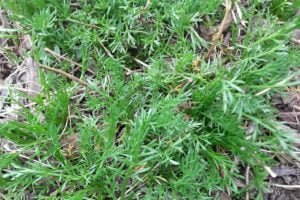
Chamomile is one of those plants that doesn’t really need much introduction. I’m sure you’ve seen it before and have at least a rough idea of what it does. However, there’s something about this plant that makes me want to share more with you about it.
What do I like about dwarf chamomile (Chamaemelum nobile)? It grows well in containers and so is perfect for the urban gardener who has little space but wants fresh herbs on their balcony or patio. The flowers are also edible, both dried and fresh, and make an excellent tea (or even jelly). And if all that isn’t enough to convince you how great these plants are then let me just say they’re incredibly easy to grow!
They are low growing and have a “fluffy” look to the 1/8″ slender leaves. The small yellow centered flowers with white petals look like miniature daisies. One of my all time favorites!
‘Treneague’ is a non-flowering variety that is often used as a lawn replacement.
Fragile Crassula
The Crassula is a succulent plant that needs to be treated with care. It may not look like it, but these plants are extremely delicate and can easily break if you don’t take proper precautions when handling them or planting them in the ground.
A succulent is a water-storing plant that has thick fleshy leaves. A typical Crassula will have long stems and small green leaves which grow close together on the stem. Some species of this genus produce flowers at their tips during summer months, often in reds or yellows tones, but more commonly white or cream colors – usually depending on the soil’s alkalinity level.
Moss Ross
Moss Ross (Portulaca grandiflora) is a beautiful flower with a lovely, delicate scent. The flowers are a range of bright colors and grow in clusters atop the plant’s stems. It is also known as Mexican Flame Flower or Indian Rose Mallow because of the shape and color resemblance to that of roses. This flower thrives best when it has plenty of sun exposure and well-drained soil.
While it is an annual, it self seeds readily and will provide you with flowers year after year.
Star Moss
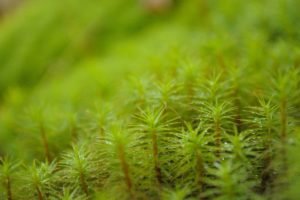
Moss is a plant that can grow in the most extreme conditions. It thrives in damp, shady, and humid areas. This moss has been used for centuries as an additive to soil because its spores are rich with nitrogen and other nutrients that help plants grow.
Star Moss (Tortula ruralis), starting from just one spore of this resilient moss, can spread out to cover up to 10 square meters (107 square feet) per year! Star Moss is so named because of the tiny star-shaped pattern on each leaflet; these leaves also give off a beautiful sheen when they catch the light.
There is a large variety of plants available with tiny leaves, from houseplants to ground covers and many not mentioned in this article. Their uses range from culinary to grass replacements to purley ornamental.
Here are 8 more for you to research on your own.
- Asparagus Fern (Asparagus aethiopicus)
- Green Carpet Rupturewort (Herniaria glabra)
- Irish Moss (Sagina subulata)
- Kenilworth Ivy (Cymbalaria muralis)
- Mini Sea Thrift (Armeria maritima)
- Silver Baby Tears (Pilea Glauca)
- Small-leaved Pennywort (Hydrocotyle peduncularis)
- Trailing Selaginella (Selaginella kraussiana)

